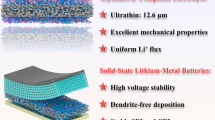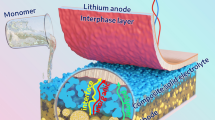Abstract
Relying on a solvent thermal method, spherical Na2Li2Ti6O14 was synthesized. All samples prepared by this method are hollow and hierarchical structures with the size of about 2–3 μm, which are assembled by many primary nanoparticles (~300 nm). Particle morphology analysis shows that with the increase of temperature, the porosity increases and the hollow structure becomes more obvious. Na2Li2Ti6O14 obtained at 800°C exhibits the best electrochemical performance among all samples. Charge-discharge results show that Na2Li2Ti6O14 prepared at 800°C can delivers a reversible capacity of 220.1, 181.7, 161.6, 144.2, 118.1 and 97.2 mA h g−1 at 50, 140, 280, 560, 1400, 2800 mA g−1. However, Na2Li2Ti6O14-bulk only delivers a reversible capacity of 187, 125.3, 108.3, 88.7, 69.2 and 54.8 mA h g−1 at the same current densities. The high electrochemical performances of the as-prepared materials can be attributed to the distinctive hollow and hierarchical spheres, which could effectively reduce the diffusion distance of Li ions, increase the contact area between electrodes and electrolyte, and buffer the volume changes during Li ion intercalation/deintercalation processes.
摘要
本文采用溶剂热法合成了球形Na2Li2Ti6O14材料. 所有溶剂热法制备得到的材料均具有中空的分级结构, 并且均由粒径约为300 nm的 初级粒子通过组装形成, 微球的直径大约为2−3 μm. 粒子的形貌分析表明, 随着合成温度的增加, 孔隙率逐渐增加且中空结构更加明显. 在 所有材料中, 800°C合成的Na2Li2Ti6O14具有最好的电化学性能. 充放电测试表明, 在电流密度为50、140、280、560、1400、2800 mA g−1时, 800°C合成的Na2Li2Ti6O14样品的可逆容量分别为220.1、181.7、161.6、144.2、118.1、97.2 mA h g−1. 但是在相同电流密度条件下, 块状的 Na2Li2Ti6O14的可逆容量分别为187、125.3、108.3、88.7、69.2、54.8 mA h g−1. 中空分级结构微球可以有效地减小锂离子的扩散距离、增 加电极与电解液的接触面积、以及缓冲锂离子嵌脱过程中的体积变化, 从而使其具有较高的电化学性能.
Similar content being viewed by others
References
Massé RC, Uchaker E, Cao G. Beyond Li-ion: electrode materials for sodium- and magnesium-ion batteries. Sci China Mater, 2015, 58: 715–766
Pan L, Zhu XD, Xie XM, et al. Smart hybridization of TiO2 nanorods and Fe3O4 nanoparticles with pristine graphene nanosheets: hierarchically nanoengineered ternary heterostructures for high-rate lithium storage. Adv Funct Mater, 2015, 25: 3341–3350
Xu H, Zhu XD, Sun KN, et al. Elaborately designed hierarchical heterostructures consisting of carbon-coated TiO2(B) nanosheets decoratedwith Fe3O4 nanoparticles for remarkable synergy in highrate lithium storage. Adv Mater Interfaces, 2015, 2: 1500239
Pan L, Zhu XD, Xie XM, et al. Delicate ternary heterostructures achieved by hierarchical co-assembly of Ag and Fe3O4 nanoparticles on MoS2 nanosheets: morphological and compositional synergy in reversible lithium storage. J Mater Chem A, 2015, 3: 2726–2733
Shen L, Yuan C, Luo H, et al. Facile synthesis of hierarchically porous Li4Ti5O12microspheres for high rate lithium ion batteries. J Mater Chem, 2010, 20: 6998–7004
Li W, Zeng L, Wu Y, et al. Nanostructured electrode materials for lithium-ion and sodium-ion batteries via electrospinning. Sci China Mater, 2016, 59: 287–321
Wang W, Wang H, Wang S, et al. Ru-doped Li4Ti5O12 anode materials for high rate lithium-ion batteries. J Power Sources, 2013, 228: 244–249
Lin X, Qian S, Yu H, et al. Advanced BaLi2Ti6O14 anode fabricated via lithium site substitution by magnesium. ACS Sustain Chem Eng, 2016, 4: 4859–4867
Dambournet D, Belharouak I, Ma J, et al. Template-assisted synthesis of high packing density SrLi2Ti6O14 for use as anode in 2.7-V lithium-ion battery. J Power Sources, 2011, 196: 2871–2874
Yin SY, Song L, Wang XY, et al. Reversible lithium storage in Li2Na2Ti6O14 as anode for lithium ion batteries. Electrochem Commun, 2009, 11: 1251–1254
Dambournet D, Belharouak I, Amine K. MLi2Ti6O14(M = Sr, Ba, 2Na) lithium insertion titanate materials: a comparative study. Inorg Chem, 2010, 49: 2822–2826
Belharouak I, Amine K. Li2Na2Ti6O14 (M=Sr, Ba): new anodes for lithium-ion batteries. Electrochem Commun, 2003, 5: 435–438
Wu K, Wang D, Lin X, et al. Comparative study ofLi2Na2Ti6O14 prepared by differentmethods as advanced anodematerial for lithiumion batteries. J Electroanal Chem, 2014, 717-718: 10–16
Khan MM, Ansari SA, Pradhan D, et al. Band gap engineered TiO2 nanoparticles for visible light induced photoelectrochemical and photocatalytic studies. J Mater Chem A, 2014, 2: 637–644
Zhang Z, Zhang L, Hedhili MN, et al. Plasmonic gold nanocrystals coupled with photonic crystal seamlessly on TiO2 nanotube photoelectrodes for efficient visible light photoelectrochemical water splitting. Nano Lett, 2013, 13: 14–20
Duan H, Li J, Du H, et al. Tailoring native defects and zinc impurities in Li4Ti5O12: insights from first-principles study. J Phys Chem C, 2015, 119: 5238–5245
Ge H, Tian H, Song H, et al. Study on the energy band structure and photoelectrochemical performances of spinel Li4Ti5O12. Mater Res Bull, 2015, 61: 459–462
Wu K, Shu J, Lin X, et al. Enhanced electrochemical performance of sodium lithium titanate by coating various carbons. J Power Sources, 2014, 272: 283–290
Lao M, Li P, Lin X, et al. Enhanced lithium storage property of Na-doped Li2Na2Ti6O14 anode materials for secondary lithium-ion batteries. RSC Adv, 2015, 5: 41999–42008
Qian S, Yu H, Yan L, et al. Ag enhanced electrochemical performance for Li2Na2Ti6O14 anode in rechargeable lithium-ion batteries. Ceramics Int, 2016, 42: 6874–6882
Wang P, Qian S, Yi TF, et al. Effect of sodium-site doping on enhancing the lithium storage performance of sodium lithium titanate. ACS Appl Mater Interfaces, 2016, 8: 10302–10314
Liu J, Du C, Tang Z, et al. In situ nickel/carbon coated lithium titanium oxide anodematerial with improved electrochemical properties. Electrochim Acta, 2014, 143: 56–62
Wu K, Lin X, Shao L, et al. Copper/carbon coated lithium sodium titanate as advanced anode material for lithium-ion batteries. J Power Sources, 2014, 259: 177–182
He N, Wang B, Huang J. Preparation and electrochemical performance of monodisperse Li4Ti5O12 hollow spheres. J Solid State Electrochem, 2010, 14: 1241–1246
Wang L, Hu Z, Zhao K, et al. Hollow spherical LiNi0.5Mn1.5O4 built from polyhedra with high-rate performance via carbon nanotube modification. Sci China Mater, 2016, 59: 95–103
Ding YL, Zhao XB, Xie J, et al. Double-shelled hollow microspheres of LiMn2O4 for high-performance lithium ion batteries. J Mater Chem, 2011, 21: 9475–9479
Shi SJ, Lou ZR, Xia TF, et al. Hollow Li1.2Mn0.5Co0.25Ni0.05O2 microcube prepared by binary template as a cathode material for lithium ion batteries. J Power Sources, 2014, 257: 198–204
Chou SL, Wang JZ, Liu HK, et al. Rapid synthesis of Li4Ti5O12 microspheres as anode materials and its binder effect for lithium-ion battery. J Phys Chem C, 2011, 115: 16220–16227
Tang Y, Yang L, Fang S, et al. Li4Ti5O12 hollowmicrospheres assembled by nanosheets as an anode material for high-rate lithium ion batteries. Electrochim Acta, 2009, 54: 6244–6249
Li J, Cao C, Xu X, et al. LiNi1/3Co1/3Mn1/3O2 hollow nano-micro hierarchical microspheres with enhanced performances as cathodes for lithium-ion batteries. J Mater Chem A, 2013, 1: 11848–11852
Shu J, Wu K, Wang P, et al. Lithiation and delithiation behavior of sodium lithium titanate anode. Electrochim Acta, 2015, 173: 595–606
Wang P, Li P, Yi TF, et al. Improved lithium storage performance of lithium sodium titanate anode by titanium site substitution with aluminum. J Power Sources, 2015, 293: 33–41
Wu K, Shu J, Lin X, et al. Phase composition and electrochemical performance of sodium lithium titanates as anode materials for lithium rechargeable batteries. J Power Sources, 2015, 275: 419–428
Yang X, Wang X, Zou G, et al. Spherical lithium-rich layered Li1.13[Mn0.534Ni0.233Co0.233]0.87O2 with concentration-gradient outer layer as high-performance cathodes for lithium ion batteries. J Power Sources, 2013, 232: 338–347
Yin SY, Feng CQ, Wu SJ, et al. Molten salt synthesis of sodium lithium titanium oxide anode material for lithium ion batteries. J Alloys Compd, 2015, 642: 1–6
Yi TF, Mei J, Zhu YR, et al. Li5Cr7Ti6O25 as a novel negative electrodematerial for lithium-ion batteries. Chem Commun, 2015, 51: 14050–14053
Yi TF, Xie Y, Zhu YR, et al. Structural and thermodynamic stability of Li4Ti5O12 anode material for lithium-ion battery. J Power Sources, 2013, 222: 448–454
Lan H, Qian S,Wang Q, et al. Sr1-x Na2x Li2Ti6O14 (0=x=1) as anode materials for rechargeable Li-ion batteries. Ceramics Int, 2017, 43: 1552–1557
Borghols WJH, Wagemaker M, Lafont U, et al. Size effects in the Li4+x Ti5O12 spinel. J Am Chem Soc, 2009, 131: 17786–17792
Yi TF, Shu J, Zhu YR, et al. High-performance Li4Ti5-x VxO12 (0=x=0.3) as an anode material for secondary lithium-ion battery. Electrochim Acta, 2009, 54: 7464–7470
Yang SY, Yuan J, Zhu YR, et al. Structure and electrochemical properties of Sc3+-doped Li4Ti5O12 as anode materials for lithium-ion battery. Ceramics Int, 2015, 41: 7073–7079
Yi TF, Han X, Yang SY, et al. Enhanced electrochemical performance of Li-rich low-Co Li1.2Mn0.56Ni0.16Co0.08-x AlxO2 (0=x=0.08) as cathode materials. Sci China Mater, 2016, 59: 618–628
Hu YS, Kienle L, Guo YG, et al. High lithium electroactivity of nanometer-sized rutile TiO2. Adv Mater, 2006, 18: 1421–1426
Acknowledgments
This work was supported by the National Natural Science Foundation of China (21301052 and 51404002), Natural Science Foundation of Heilongjiang Province (E2016056), Specialized Research Fund for the Doctoral Program of Higher Education (20132301120001), Postdoctoral Science-Research Developmental Foundation of Heilongjiang Province (LBH-Q13138), and Applied Technology Research and Development Program of Harbin (2015RAQXJ032).
Author information
Authors and Affiliations
Corresponding authors
Additional information
Shan-Shan Fan received her BSc degree in applied chemistry from Luoyang Normal University in 2015. She entered Heilongjiang University to pursue her master’s degree in science in 2015. She is interested in the application of quantum chemistry and the synthesis and electrochemical performance of anode materials for lithium ion battery applications.
Ying Xie received his BE degree in fine chemical engineering from Harbin University of Science and Technology in 2002. He then obtained MSc degree in chemical engineering in 2004 and PhD degree in chemical engineering and technology from Harbin Institute of Technology in 2008. He joined Heilongjiang University in 2008, and then became a member of the Key Laboratory of Functional InorganicMaterial Chemistry. He is currently a professor of Heilongjiang University. His research interests include theoretical predictions on the structures and properties of inorganic compounds and the synthesis of electrode materials and their applications in lithium-ion battery.
Electronic supplementary material
40843_2017_9033_MOESM1_ESM.pdf
Hollow and hierarchical Na2Li2Ti6O14 micro spheres with high electrochemical performance as anode material for lithium-ion battery
Rights and permissions
About this article
Cite this article
Fan, SS., Zhong, H., Yu, HT. et al. Hollow and hierarchical Na2Li2Ti6O14 microspheres with high electrochemical performance as anode material for lithium-ion battery. Sci. China Mater. 60, 427–437 (2017). https://doi.org/10.1007/s40843-017-9033-5
Received:
Accepted:
Published:
Issue Date:
DOI: https://doi.org/10.1007/s40843-017-9033-5




